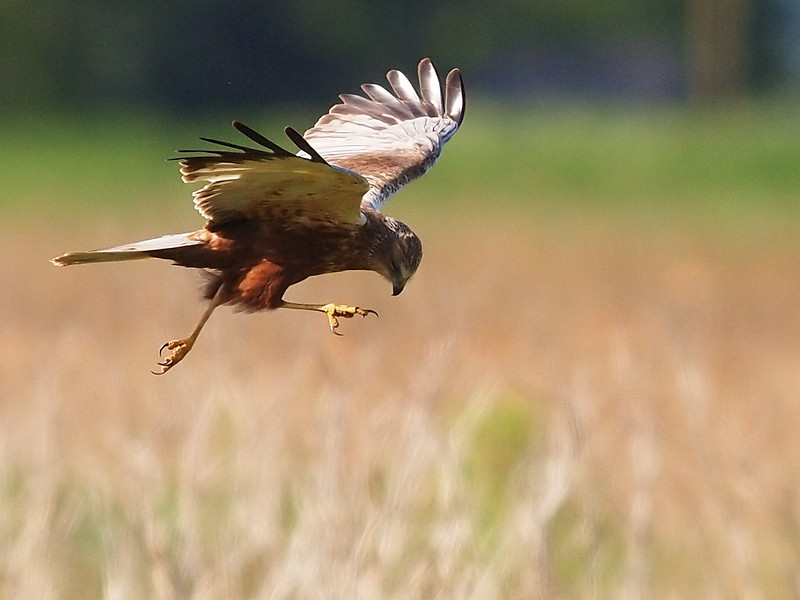Yes, Birds in Flight - it's something the E-5, E-30 and E-3 are better, much better, at than any Pen or the OM-D E-M5, although Nikon and Canon are undoubtedly better at still (with some models at least).

It's all about autofocus and being able to continuously focus on a bird and not anything else in the frame, while shooting continuously at a reasonably high frame rate.
The E-5, E30 and E-3 DSLRs focus better for this type of photography than Olympus' Micro Four Thirds mirrorless cameras because DSLRs rely on phase detect (PDAF) or range-finding autofocus. PDAF is less likely to be confused while trying to establish focus on a subject that is not stable on the frame. If it gets a partial focus on a subject it knows immediately which way to focus and even to an extent how far it needs to change focus.
Four Thirds lenses are also geared (literally) for PDAF. The mechanical optimisations made for PDAF mean they don't work well with mirrorless Pen and OM-D contrast detect AF. So the general assumption is that Olympus will some how implement PDAF in the promised new camera which various Olympus statements have said will work normally with Four Thirds lenses.

None of the above is new and has been discussed many times in many places. But what I would like to get to the bottom of is just how difficult BIF photography is. I have tried it many times with DSLRs and mirrorless cameras and I have come to the conclusion that you need to be highly skilled to be able to get a consistently high success rate - even if you have a high-spec. camera.
I have included a couple of my own BIF shots above and I am pretty pleased with them but I also have to admit that these are very much 'success by chance' shots
I believe that you simply can't just wave a camera and lens around at a flying bird in the vague hope of getting a great shot. I hope some of our esteemed bird photographers here can confirm that you need to do some advance planning, anticipating which direction the bird will be travelling in, establishing the right moment to start shooting and therefore locking focus and of course to use the correct camera modes and settings.
For example, C-AF requires continuous shooting in L-mode, not H-mode - which only focuses once at the beginning of the sequence. Using the correct selection of AF points is important, and steady tracking of your subject is also essential.
I'm personally keen to learn more about this so please do post hints and tips here if possible
Ian

It's all about autofocus and being able to continuously focus on a bird and not anything else in the frame, while shooting continuously at a reasonably high frame rate.
The E-5, E30 and E-3 DSLRs focus better for this type of photography than Olympus' Micro Four Thirds mirrorless cameras because DSLRs rely on phase detect (PDAF) or range-finding autofocus. PDAF is less likely to be confused while trying to establish focus on a subject that is not stable on the frame. If it gets a partial focus on a subject it knows immediately which way to focus and even to an extent how far it needs to change focus.
Four Thirds lenses are also geared (literally) for PDAF. The mechanical optimisations made for PDAF mean they don't work well with mirrorless Pen and OM-D contrast detect AF. So the general assumption is that Olympus will some how implement PDAF in the promised new camera which various Olympus statements have said will work normally with Four Thirds lenses.

None of the above is new and has been discussed many times in many places. But what I would like to get to the bottom of is just how difficult BIF photography is. I have tried it many times with DSLRs and mirrorless cameras and I have come to the conclusion that you need to be highly skilled to be able to get a consistently high success rate - even if you have a high-spec. camera.
I have included a couple of my own BIF shots above and I am pretty pleased with them but I also have to admit that these are very much 'success by chance' shots

I believe that you simply can't just wave a camera and lens around at a flying bird in the vague hope of getting a great shot. I hope some of our esteemed bird photographers here can confirm that you need to do some advance planning, anticipating which direction the bird will be travelling in, establishing the right moment to start shooting and therefore locking focus and of course to use the correct camera modes and settings.
For example, C-AF requires continuous shooting in L-mode, not H-mode - which only focuses once at the beginning of the sequence. Using the correct selection of AF points is important, and steady tracking of your subject is also essential.
I'm personally keen to learn more about this so please do post hints and tips here if possible

Ian








 ), I found this info sheet, supplied by Andy Elliott (OlyOM) a while ago prior to a shoot at the Cambridgeshire Raptor Centre with my E-3.
), I found this info sheet, supplied by Andy Elliott (OlyOM) a while ago prior to a shoot at the Cambridgeshire Raptor Centre with my E-3.





Comment